Role of Christianity in civilization
| Part of a series on |
| Christian culture |
|---|
 |
| Christianity portal |
The role of Christianity in civilization has been intricately intertwined with the history and formation of Western society. Throughout its long history, the Christian Church has been a major source of social services like schooling and medical care; inspiration for art, culture and philosophy; and influential player in politics and religion. In various ways it has sought to affect Western attitudes to vice and virtue in diverse fields. It has, over many centuries, promulgated the teachings of Jesus within the Western world as well as throughout other third-world nations. Festivals like Easter and Christmas are marked as public holidays; the Gregorian Calendar has been adopted internationally as the civil calendar; and the calendar itself is measured from the date of Jesus's birth.
The cultural influence of the Church has been vast. Church scholars preserved literacy in Western Europe following the Fall of the Western Roman Empire.[1] During the Middle Ages, the Church rose to replace the Roman Empire as the unifying force in Europe. The cathedrals of that age remain among the most iconic feats of architecture produced by Western civilization. Many of Europe's universities were also founded by the church at that time. Many historians state that universities and cathedral schools were a continuation of the interest in learning promoted by monasteries.[2] The university is generally regarded as an institution that has its origin in the Medieval Christian setting.[3][4] The Reformation brought an end to religious unity in the West, but the Renaissance masterpieces produced by Catholic artists like Michelangelo, Leonardo da Vinci and Raphael at that time remain among the most celebrated works of art ever produced. Similarly, Christian sacred music by composers like Pachelbel, Vivaldi, Bach, Handel, Mozart, Haydn, Beethoven, Schubert and Verdi is among the most admired classical music in the Western canon.
The Bible and Christian theology have also strongly influenced Western philosophers and political activists. The teachings of Jesus, such as the Parable of the Good Samaritan, are among the important sources for modern notions of Human Rights and the welfare measures commonly provided by governments in the West. Long held Christian teachings on sexuality and marriage and family life have also been both influential and (in recent times) controversial. Christianity played a role in ending practices such as human sacrifice, slavery,[5] infanticide and polygamy.[6] Christianity in general affected the status of women by condemning infanticide (female infants were more likely to be killed), divorce, incest, polygamy, birth control, abortion and marital infidelity.[7] While official Church teaching[8] considers women and men to be complementary (equal and different), some modern "advocates of ordination of women and other feminists" argue that teachings attributed to St. Paul and those of the Fathers of the Church and Scholastic theologians advanced the notion of a divinely ordained female inferiority.[9] Nevertheless, women have played prominent roles in Western history through as part of the church, particularly in education and healthcare, but also as influential theologians and mystics.
Some of the things that Christianity is commonly criticized for include the oppression of women, condemnation of homosexuality, colonialism, and various other violence. Christian ideas have been used both to support and to end slavery as an institution. The criticism of Christianity has come from the various religious and non-religious groups around the world, some of whom were themselves Christians.
Politics and law
From persecuted minority to State Religion
Christianity began as a Jewish sect in the mid-1st century arising out of the life and teachings of Jesus of Nazareth. The life of Jesus is recounted in the New Testament of the Bible, one of the bedrock texts of Western Civilization and inspiration for countless works of Western art.[10] Jesus' birth is commemorated in the festival of Christmas, his death during the Paschal Triduum, and what Christians believe to be his resurrection during Easter. Christmas and Easter remain holidays in many Western nations. Jesus learned the texts of the Hebrew Bible, with its Ten Commandments (which later became influential in Western law) and became an influential wandering preacher. He was a persuasive teller of parables and moral philosopher who urged followers to worship God, act without violence or prejudice and care for the sick, hungry and poor. These teachings have been deeply influential in Western culture. Jesus criticized the privilege and hypocrisy of the religious establishment which drew the ire of the authorities, who persuaded the Roman Governor of the province of Judaea, Pontius Pilate, to have him executed for subversion. In Jerusalem, around 30AD, Jesus was crucified.[11]
The early followers of Jesus, including Saints Paul and Peter carried a new theology concerning him throughout the Roman Empire and beyond, sowing the seeds for the development of the Catholic Church, of which Saint Peter is remembered as the first Pope. Catholicism, as we know it, emerged slowly. Christians often faced persecution during these early centuries, particularly for their refusal to join in worshiping the emperors. Nevertheless, carried through the synagogues, merchants and missionaries across the known world, the new internationalist religion quickly grew in size and influence.[11]
Emperor Constantine's Edict of Milan in 313 AD ended the persecutions and his own conversion to Christianity was a significant turning point in history.[12] In 312, Constantine offered civic toleration to Christians, and through his reign instigated laws and policies in keeping with Christian principles – making Sunday the Sabbath "day of rest" for Roman society (though initially this was only for urban dwellers) and embarking on a church building program. In AD 325, Constantine conferred the First Council of Nicaea to gain consensus and unity within Christianity, with a view to establishing it as the religion of the Empire. The population and wealth of the Roman Empire had been shifting east, and around the year 330, Constantine established the city of Constantinople as a new imperial city which would be the capital of the Eastern Roman Empire. The Eastern Patriarch in Constantinople now came to rival the Pope in Rome and Rome itself was sacked by the Visigoths in 410 and the Vandals in 455. Although cultural continuity and interchange would continue between these Eastern and Western Roman Empires, the history of Christianity and Western culture took divergent routes, with a final Great Schism separating Roman and Eastern Christianity in 1054AD.


The remarkable transformation of Christianity from peripheral sect, to major force within the Empire is illustrated by the influence held by St Ambrose, the Bishop of Milan. A Doctor of the Church and one of the most influential ecclesiastical figures of the 4th century, Ambrose became a player in Imperial politics, courted for his influence by competing contenders for the Imperial throne. When the Emperor Theodosius I ordered the punitive massacre of thousands of the citizens of Thessaloniki, Ambrose admonished him publicly, refused him the Eucharist and called on him to perform a public penance, a call to which the Christian Emperor submitted.[13] While paganism in the Roman Empire was not yet finished, the episode prefigured the role of the Church in the political life of Europe in coming centuries.
Theodosius reigned (albeit for a brief interim) as the last Emperor of a united Eastern and Western Roman Empire. In 391 Theodosius sought to block the restoration of the pagan Altar of Victory to the Roman Senate and then fought against Eugenius, who courted pagan support for his own bid for the imperial throne. Thus, the Catholic Encyclopedia lauds Theodosius as:[14]
| “ | [O]ne of the sovereigns by universal consent called Great. He stamped out the last vestiges of paganism, put an end to the Arian heresy in the empire, pacified the Goths, left a famous example of penitence for a crime, and reigned as a just and mighty Catholic emperor. | ” |
After the Fall of Rome, the papacy served as a source of authority and continuity. In the absence of a magister militum living in Rome, even the control of military matters fell to the pope. Gregory the Great (c 540–604) administered the church with strict reform. A trained Roman lawyer and administrator, and a monk, he represents the shift from the classical to the medieval outlook and was a father of many of the structures of the later Roman Catholic Church. According to the Catholic Encyclopedia, he looked upon Church and State as co-operating to form a united whole, which acted in two distinct spheres, ecclesiastical and secular, but by the time of his death, the papacy was the great power in Italy:[15]
| “ | [ Pope Gregory the Great ] made himself in Italy a power stronger than emperor or exarch, and established a political influence which dominated the peninsula for centuries. From this time forth the varied populations of Italy looked to the pope for guidance, and Rome as the papal capital continued to be the centre of the Christian world. | ” |
Medieval period

The historian of Christianity, Geoffrey Blainey, likened the Catholic Church in its activities during the Middle Ages to an early version of a welfare state: "It conducted hospitals for the old and orphanages for the young; hospices for the sick of all ages; places for the lepers; and hostels or inns where pilgrims could buy a cheap bed and meal". It supplied food to the population during famine and distributed food to the poor. This welfare system the church funded through collecting taxes on a large scale and possessing large farmlands and estates.[16]
By the late 11th century, beginning with the efforts of Pope Gregory VII, the Church successfully established itself as "an autonomous legal and political ... [entity] within Western Christendom".[17] For the next several hundred years, the Church held great influence over Western society;[17] church laws were the single "universal law ... common to jurisdictions and peoples throughout Europe", giving the Church "preeminent authority".[18] With its own court system, the Church retained jurisdiction over many aspects of ordinary life, including education, inheritance, oral promises, oaths, moral crimes, and marriage.[19] As one of the more powerful institutions of the Middle Ages, Church attitudes were reflected in many secular laws of the time.[20]
The Catholic Church was very powerful, essentially internationalist and democratic in it structures and run by monastic organisations generally following Benedictine rule. Men of a scholarly bent usually took Holy Orders and frequently joined religious institutes. Those with intellectual, administrative or diplomatic skill could advance beyond the usual restraints of society – leading churchmen from faraway lands were accepted in local bishoprics, linking European thought across wide distances. Complexes like the Abbey of Cluny became vibrant centres with dependencies spread throughout Europe. Ordinary people also treked vast distances on pilgrimages to express their piety and pray at the site of holy relics.[21]
Women were in many respects excluded from political and mercantile life; however, some leading churchwomen were exceptions. Medieval abbesses and female superiors of monastic houses were powerful figures whose influence could rival that of male bishops and abbots: "They treated with kings, bishops, and the greatest lords on terms of perfect equality;... they were present at all great religious and national solemnities, at the dedication of churches, and even, like the queens, took part in the deliberation of the national assemblies...".[22] The increasing popularity of devotion to the Virgin Mary (the mother of Jesus) secured maternal virtue as a central cultural theme of Catholic Europe. Kenneth Clarke wrote that the 'Cult of the Virgin' in the early 12th century "had taught a race of tough and ruthless barbarians the virtues of tenderness and compassion".[23]
Charlemagne ("Charles the Great" in English) became king of the Franks. He conquered the Low Countries, Saxony, and northern and central Italy and 800, Pope Leo III crowned Charlemagne Holy Roman Emperor. Relations between the major powers in Western society: the nobility, monarchy and clergy, sometimes produced conflict. Pope's were powerful enough to challenge the authority of kings. The Investiture Controversy was perhaps the most significant conflict between Church and state in medieval Europe. A series of Popes challenged the authority of monarchies over control of appointments, or investitures, of church officials. The Court of Holy Roman Emperor Frederick II, based in Sicily, saw tension and rivalry with the Papacy over control of Northern Italy.[24] The Papacy had its court at Avignon from 1305–78[25] This arose from the conflict between the Papacy and the French crown.
In 1054, after centuries of strained relations, the Great Schism occurred over differences in doctrine, splitting the Christian world between the Catholic Church, centered in Rome and dominant in the West, and the Orthodox Church, centered in Constantinople, capital of the Byzantine Empire.
In 1095, Pope Urban II called for a Crusade to re-conquer the Holy Land from Muslim rule, when the Seljuk Turks prevented Christians from visiting the holy sites there. The lands had previously been controlled by the Roman Empire, but despite the initial success of the First Crusade, the conflicts ultimately ended in failure.
The period produced ever more extravagant art and architecture, but also the virtuous simplicity of such as St Francis of Assisi (expressed in the Canticle of the Sun) and the epic poetry of Dante's Divine Comedy. As the Church grew more powerful and wealthy, many sought reform. The Dominican and Franciscan Orders were founded, which emphasized poverty and spirituality.
Reformation until Modern era
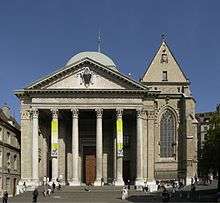
In the Middle Ages, the Church and the worldly authorities were closely related. Martin Luther separated the religious and the worldly realms in principle (doctrine of the two kingdoms).[26] The believers were obliged to use reason to govern the worldly sphere in an orderly and peaceful way. Luther's doctrine of the priesthood of all believers upgraded the role of laymen in the church considerably. The members of a congregation had the right to elect a minister and, if necessary, to vote for his dismissal (Treatise On the right and authority of a Christian assembly or congregation to judge all doctrines and to call, install and dismiss teachers, as testified in Scripture; 1523).[27] Calvin strengthened this basically democratic approach by including elected laymen (church elders, presbyters) in his representative church government.[28] The Huguenots added regional synods and a national synod, whose members were elected by the congregations, to Calvin's system of church self-government. This system was taken over by the other Reformed churches.[29]
Politically, John Calvin favoured a mixture of aristocracy and democracy. He appreciated the advantages of democracy: "It is an invaluable gift, if God allows a people to freely elect its own authorities and overlords."[30] Calvin also thought that earthly rulers lose their divine right and must be put down when they rise up against God. To further protect the rights of ordinary people, Calvin suggested separating political powers in a system of checks and balances (separation of powers). Thus he and his followers resisted political absolutism and paved the way for the rise of modern democracy.[31] Besides England, the Netherlands were, under Calvinist leadership, the freest country in Europe in the seventeenth and eighteenth centuries. It granted asylum to philosophers like René Descartes, Baruch Spinoza and Pierre Bayle. Hugo Grotius was able to teach his natural-law theory and a relatively liberal interpretation of the Bible.[32]
Consistent with Calvin's political ideas, Protestants created both the English and the American democracies. In 17th-century England, the most important persons and events in this process were the English Civil War, Oliver Cromwell, John Milton, John Locke, the Glorious Revolution, the English Bill of Rights, and the Act of Settlement.[33] Later, the British took their democratic ideals also to their colonies, e.g. Australia, New Zealand, and India. In the 19th and 20th centuries, the British variety of modern-time democracy, constitutional monarchy, was taken over by Protestant-formed Sweden, Norway, Denmark, and the Netherlands as well as the Catholic countries Belgium and Spain. In North America, Plymouth Colony (Pilgrim Fathers; 1620) and Massachusetts Bay Colony (1628) practised democratic self-rule and separation of powers.[34][35][36][37] These Congregationalists were convinced that the democratic form of government was the will of God.[38] The Mayflower Compact was a social contract.[39][40]
Sexual mores
Early Church Fathers advocated against polygamy, homosexuality, transvestism, and incest.[41] Historically, Christian churches have regarded homosexual sex as sinful, based on the Catholic understanding of the natural law and traditional interpretations of certain passages in the Bible.
Marriage and family life

The teachings of the Church have also been used to "establish[...] the status of women under the law".[42] There has been some debate as to whether the Church has improved the status of women or hindered their progress.
.jpg)
From the beginning of the thirteenth century, the Church formally recognized marriage between a freely consenting, baptized man and woman as a sacrament—an outward sign communicating a special gift of God's love. The Council of Florence in 1438 gave this definition, following earlier Church statements in 1208, and declared that sexual union was a special participation in the union of Christ in the Church.[43] However, the Puritans, while highly valuing the institution, viewed marriage as a "civil", rather than a "religious" matter, being "under the jurisdiction of the civil courts".[44] This is because they found no biblical precedent for clergy performing marriage ceremonies. Further, marriage was said to be for the "relief of concupiscence"[44] as well as any spiritual purpose.
During the Protestant Reformation, Martin Luther and John Calvin denied the sacramentality of marriage. This unanimity was broken at the 1930 Lambeth Conference, the quadrennial meeting of the worldwide Anglican Communion—creating divisions in that denomination.
Sex before marriage was not a taboo in the Anglican Church until the "Hardwicke Marriage Act of 1753, which for the first time stipulated that everyone in England and Wales had to be married in their parish church"[45] Prior to that time, "marriage began at the time of betrothal, when couples would live and sleep together... The process begun at the time of the Hardwicke Act continued throughout the 1800s, with stigma beginning to attach to illegitimacy."[45]
Scriptures in the New Testament dealing with sexuality are extensive. Subjects include: the Apostolic Decree (Acts 15), sexual immorality, divine love (1 Corinthians 13), mutual self-giving (1 Corinthians 7), bodily membership between Christ and between husband and wife (1 Corinthians 6:15–20) and honor versus dishonor of adultery(Hebrews 13:4).
Roman Empire
Social structures at the dawn of Christianity in the Roman Empire held that women were inferior to men intellectually and physically and were "naturally dependent".[46] Athenian women were legally classified as children regardless of age and were the "legal property of some man at all stages in her life."[47] Women in the Roman Empire had limited legal rights and could not enter professions. Female infanticide and abortion were practiced by all classes.[47] In family life, men could have "lovers, prostitutes and concubines" but wives who engaged in extramarital affairs were considered guilty of adultery. It was not rare for pagan women to be married before the age of puberty and then forced to consummate the marriage with her often much older husband. Husbands could divorce their wives at any time simply by telling the wife to leave; wives did not have a similar ability to divorce their husbands.[46]
Early Church Fathers advocated against polygamy, abortion, infanticide, child abuse, homosexuality, transvestism, and incest.[41] Although some Christian ideals were adopted by the Roman Empire, there is little evidence to link most of these laws to Church influence.[48] After the Roman Empire adopted Christianity as the official religion, however, the link between Christian teachings and Roman family laws became more clear.[49]
For example, Church teaching heavily influenced the legal concept of marriage.[50] During the Gregorian Reform, the Church developed and codified a view of marriage as a sacrament.[17] In a departure from societal norms, Church law required the consent of both parties before a marriage could be performed[41] and established a minimum age for marriage.[51] The elevation of marriage to a sacrament also made the union a binding contract, with dissolutions overseen by Church authorities.[52] Although the Church abandoned tradition to allow women the same rights as men to dissolve a marriage,[53] in practice, when an accusation of infidelity was made, men were granted dissolutions more frequently than women.[54]
Medieval period
According to historian Shulamith Shahar, "[s]ome historians hold that the Church played a considerable part in fostering the inferior status of women in medieval society in general" by providing a "moral justification" for male superiority and by accepting practices such as wife-beating.[55] Despite these laws, some women, particularly abbesses, gained powers that were never available to women in previous Roman or Germanic societies.[56]
Although these teachings emboldened secular authorities to give women fewer rights than men, they also helped form the concept of chivalry.[57] Chivalry was influenced by a new Church attitude towards Mary, the mother of Jesus.[58] This "ambivalence about women's very nature" was shared by most major religions in the Western world.[59]
Slavery
The Church initially accepted slavery as part of the social fabric of society during the Roman Empire and early antiquity, campaigning primarily for humane treatment of slaves but also admonishing slaves to behave appropriately towards their masters.[60] During the early medieval period, this attitude changed to one which opposed enslavement of Christians but still tolerated enslavement of non-Christians. By the end of the Medieval period, enslavement of Christians had been mitigated somewhat with the spread of serfdom within Europe, though outright slavery existed in European colonies in other parts of the world. Several popes issued papal bulls condemning mistreatment of enslaved Native Americans; these were largely ignored. In his 1839 bull In supremo apostolatus, Pope Gregory XVI condemned all forms of slavery; nevertheless some American bishops continued to support slavery for several decades.[61] In this historic Bull, Pope Gregory outlined his summation of the impact of the Church on the ancient institution of slavery, beginning by acknowledging that early Apostles had tolerated slavery but had called on masters to "act well towards their slaves... knowing that the common Master both of themselves and of the slaves is in Heaven, and that with Him there is no distinction of persons". Gregory continued to discuss the involvement of Christians for and against slavery through the ages:[62]
| “ | In the process of time, the fog of pagan superstition being more completely dissipated and the manners of barbarous people having been softened, thanks to Faith operating by Charity, it at last comes about that, since several centuries, there are no more slaves in the greater number of Christian nations. But – We say with profound sorrow – there were to be found afterwards among the Faithful men who, shamefully blinded by the desire of sordid gain, in lonely and distant countries, did not hesitate to reduce to slavery Indians, negroes and other wretched peoples, or else, by instituting or developing the trade in those who had been made slaves by others, to favour their unworthy practice. Certainly many Roman Pontiffs of glorious memory, Our Predecessors, did not fail, according to the duties of their charge, to blame severely this way of acting as dangerous for the spiritual welfare of those engaged in the traffic and a shame to the Christian name; they foresaw that as a result of this, the infidel peoples would be more and more strengthened in their hatred of the true Religion. | ” |
Latin America
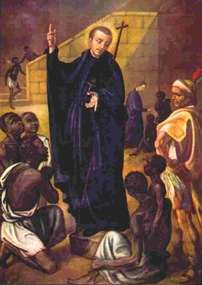
It was women, primarily Amerindian Christian converts who became the primary supporters of the Latin American Church.[63] While the Spanish military was known for its ill-treatment of Amerindian men and women, Catholic missionaries are credited with championing all efforts to initiate protective laws for the Indians and fought against their enslavement. This began within 20 years of the discovery of the New World by Europeans in 1492 – in December 1511, Antonio de Montesinos, a Dominican friar, openly rebuked the Spanish rulers of Hispaniola for their "cruelty and tyranny" in dealing with the American natives.[64] King Ferdinand enacted the Laws of Burgos and Valladolid in response. The issue resulted in a crisis of conscience in 16th-century Spain.[65] Further abuses against the Amerindians committed by Spanish authorities were denounced by Catholic missionaries such as Bartolomé de Las Casas and Francisco de Vitoria which led to debate on the nature of human rights[66] and the birth of modern international law.[67] Enforcement of these laws was lax, and some historians blame the Church for not doing enough to liberate the Indians; others point to the Church as the only voice raised on behalf of indigenous peoples.[68]
Slavery and human sacrifice were both part of Latin American culture before the Europeans arrived. Indian slavery was first abolished by Pope Paul III in the 1537 bull Sublimis Deus which confirmed that "their souls were as immortal as those of Europeans" and they should neither be robbed nor turned into slaves.[69] While these edicts may have had some beneficial effects, these were limited in scope. European colonies were mainly run by military and royally-appointed administrators, who seldom stopped to consider church teachings when forming policy or enforcing their rule. Even after independence, institutionalized prejudice and injustice toward indigenous people continued well into the twentieth century. This has led to the formation of a number of movements to reassert indigenous peoples' civil rights and culture in modern nation-states.
A catastrophe was wrought upon the Amerindians by contact with Europeans. Old World diseases like smallpox, measles, malaria and many others spread through Indian populations. "In most of the New World 90 percent or more of the native population was destroyed by wave after wave of previously unknown afflictions. Explorers and colonists did not enter an empty land but rather an emptied one".[70]
Africa
Slavery and the slave trade were part of African societies and states which supplied the Arab world with slaves before the arrival of the Europeans.[71] Several decades prior to discovery of the New World, in response to serious military threat to Europe posed by Muslims of the Ottoman Empire, Pope Nicholas V had granted Portugal the right to subdue Muslims, pagans and other unbelievers in the papal bull Dum Diversas (1452).[72] Six years after African slavery was first outlawed by the first major entity to do so, (Great Britain in 1833), Pope Gregory XVI followed in a challenge to Spanish and Portuguese policy, by condemning slavery and the slave trade in the 1839 papal bull In supremo apostolatus, and approved the ordination of native clergy in the face of government racism.[73] The United States would eventually outlaw African slavery in 1865.
By the close of the 19th century, European powers had managed to gain control of most of the African interior.[74] The new rulers introduced cash-based economies which created an enormous demand for literacy and a western education—a demand which for most Africans could only be satisfied by Christian missionaries.[74] Catholic missionaries followed colonial governments into Africa, and built schools, hospitals, monasteries and churches.[74]
Letters and learning
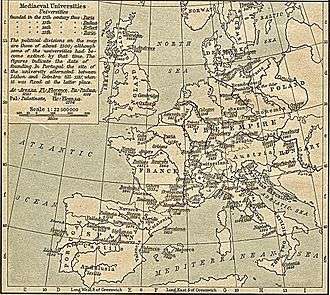
The influence of the Church on Western letters and learning has been formidable. The ancient texts of the Bible have deeply influenced Western art, literature and culture. For centuries following the collapse of the Western Roman Empire, small monastic communities were practically the only outposts of literacy in Western Europe. In time, the Cathedral schools developed into Europe's earliest universities and the church has established thousands of primary, secondary and tertiary institutions throughout the world in the centuries since. The Church and clergymen have also sought at different times to censor texts and scholars. Thus different schools of opinion exist as to the role and influence of the Church in relation to western letters and learning.
One view, first propounded by Enlightenment philosophers, asserts that the Church's doctrines are entirely superstitious and have hindered the progress of civilization. Communist states have made similar arguments in their education in order to inculcate a negative view of Catholicism (and religion in general) in their citizens. The most famous incidents cited by such critics are the Church's condemnations of the teachings of Copernicus, Galileo Galilei and Johannes Kepler.
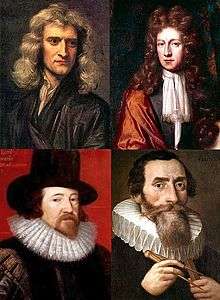
In opposition to this view, some historians of science, including non-Catholics such as J.L. Heilbron,[75] A.C. Crombie, David Lindberg,[76] Edward Grant, Thomas Goldstein,[77] and Ted Davis, have argued that the Church had a significant, positive influence on the development of Western civilization. They hold that, not only did monks save and cultivate the remnants of ancient civilization during the barbarian invasions, but that the Church promoted learning and science through its sponsorship of many universities which, under its leadership, grew rapidly in Europe in the 11th and 12th centuries. St.Thomas Aquinas, the Church's "model theologian," argued that reason is in harmony with faith, and that reason can contribute to a deeper understanding of revelation, and so encouraged intellectual development.[78] The Church's priest-scientists, many of whom were Jesuits, have been among the leading lights in astronomy, genetics, geomagnetism, meteorology, seismology, and solar physics, becoming some of the "fathers" of these sciences. Examples include important churchmen such as the Augustinian abbot Gregor Mendel (pioneer in the study of genetics), Roger Bacon (a Franciscan friar who was one of the early advocates of the scientific method), and Belgian priest Georges Lemaître (the first to propose the Big Bang theory). Other notable priest scientists have included Albertus Magnus, Robert Grosseteste, Nicholas Steno, Francesco Grimaldi, Giambattista Riccioli, Roger Boscovich, and Athanasius Kircher. Even more numerous are Catholic laity involved in science:Henri Becquerel who discovered radioactivity; Galvani, Volta, Ampere, Marconi, pioneers in electricity and telecommunications; Lavoisier, "father of modern chemistry"; Vesalius, founder of modern human anatomy; and Cauchy, one of the mathematicians who laid the rigorous foundations of calculus.
Many well-known historical figures who influenced Western science considered themselves Christian such as Copernicus,[79] Galileo,[80] Kepler,[81] Newton[82] and Boyle.[83]
According to 100 Years of Nobel Prize (2005), a review of Nobel prizes awarded between 1901 and 2000, 65.4% of Nobel Prize Laureates, have identified Christianity in its various forms as their religious preference (423 prizes).[84] Overall, Christians have won a total of 78.3% of all the Nobel Prizes in Peace,[85] 72.5% in Chemistry, 65.3% in Physics,[85] 62% in Medicine,[85] 54% in Economics[85] and 49.5% of all Literature awards.[85]
Antiquity
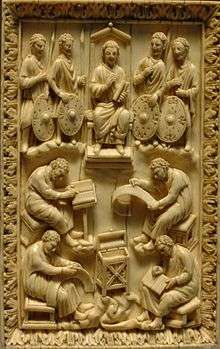
Christianity began as a Jewish sect in the 1st century AD, and from the teachings of Jesus of Nazareth and his early followers. Jesus learned the texts of the Hebrew Bible and became an influential wandering preacher. Accounts of his life and teachings appear in the New Testament of the Bible, one of the bedrock texts of Western Civilisation.[10] His orations, including the Sermon on the Mount, The Good Samaritan and his declaration against hypocrisy "Let he who is without sin cast the first stone" have been deeply influential in Western literature. Many translations of the Bible exist, including the King James Bible, which is one of the most admired texts in English literature. The poetic Psalms and other passages of the Hebrew Bible have also been deeply influential in Western Literature and thought. Accounts of the actions of Jesus' early followers are contained within the Acts of the Apostles and Epistles written between the early Christian communities – in particular the Pauline epistles which are among the earliest extant Christian documents and foundational texts of Christian theology.
After the death of Jesus, the new sect grew to be the dominant religion of the Roman Empire and the long tradition of Christian scholarship began. When the Western Roman Empire was starting to disintegrate, St Augustine was Bishop of Hippo Regius.[86] He was a Latin-speaking philosopher and theologian who lived in the Roman Africa Province. His writings were very influential in the development of Western Christianity and he developed the concept of the Church as a spiritual City of God (in a book of the same name), distinct from the material Earthly City.[87] His book Confessions, which outlines his sinful youth and conversion to Christianity, is widely considered to be the first autobiography of ever written in the canon of Western Literature. Augustine profoundly influenced the coming medieval worldview.[88]
Byzantine Empire

The writings of Classical antiquity never ceased to be cultivated in Byzantium. Therefore, Byzantine science was in every period closely connected with ancient philosophy, and metaphysics.[89] In the field of engineering Isidore of Miletus, the Greek mathematician and architect of the Hagia Sophia, produced the first compilation of Archimedes works c. 530, and it is through this tradition, kept alive by the school of mathematics and engineering founded c. 850 during the "Byzantine Renaissance" by Leo the Geometer that such works are known today (see Archimedes Palimpsest).[90] Indeed, geometry and its applications (architecture and engineering instruments of war) remained a specialty of the Byzantines.

Though scholarship lagged during the dark years following the Arab conquests, during the so-called Byzantine Renaissance at the end of the first millennium Byzantine scholars re-asserted themselves becoming experts in the scientific developments of the Arabs and Persians, particularly in astronomy and mathematics.[91] The Byzantines are also credited with several technological advancements, particularly in architecture (e.g. the pendentive dome) and warfare technology (e.g. Greek fire).
Although at various times the Byzantines made magnificent achievements in the application of the sciences (notably in the construction of the Hagia Sophia), and although they preserved much of the ancient knowledge of science and geometry, after the 6th century Byzantine scholars made few novel contributions to science in terms of developing new theories or extending the ideas of classical authors.[92]
In the final century of the Empire, Byzantine grammarians were those principally responsible for carrying, in person and in writing, ancient Greek grammatical and literary studies to early Renaissance Italy.[93] During this period, astronomy and other mathematical sciences were taught in Trebizond; medicine attracted the interest of almost all scholars.[94]
In the field of law, Justinian I's reforms had a clear effect on the evolution of jurisprudence, and Leo III's Ecloga influenced the formation of legal institutions in the Slavic world.[95] In the 10th century, Leo VI the Wise achieved the complete codification of the whole of Byzantine law in Greek, which became the foundation of all subsequent Byzantine law, generating interest to the present day.
Preservation of Classical learning
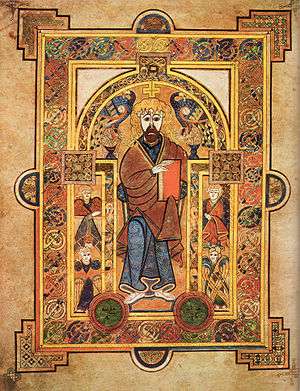
During the period of European history often called the Dark Ages which followed the collapse of the Western Roman Empire, Church scholars and missionaries played a vital role in preserving knowledge of Classical Learning. While the Roman Empire and Christian religion survived in an increasingly Hellenised form in the Byzantine Empire centred at Constantinople in the East, Western civilisation suffered a collapse of literacy and organisation following the fall of Rome in 476AD. Monks sought refuge at the far fringes of the known world: like Cornwall, Ireland, or the Hebrides. Disciplined Christian scholarship carried on in isolated outposts like Skellig Michael in Ireland, where literate monks became some of the last preservers in Western Europe of the poetic and philosophical works of Western antiquity.[96] By around 800AD they were producing illuminated manuscripts such as the Book of Kells, by which old learning was re-communicated to Western Europe. The Hiberno-Scottish mission led by Irish and Scottish monks like St Columba spread Christianity back into Western Europe during the Middle Ages, establishing monasteries through Anglo-Saxon England and the Frankish Empire during the Middle Ages.
Thomas Cahill, in his 1995 book How the Irish Saved Civilization, credited Irish Monks with having "saved" Western Civilization:[97]
| “ | [A]s the Roman Empire fell, as all through Europe matted, unwashed barbarians descended on the Roman cities, looting artifacts and burning books, the Irish, who were just learning to read and write, took up th great labor of copying all western literature – everything they could lay their hands on. These scribes then served as conduits through which the Greco-Roman and Judeo-Christian cultures were transmitted to the tribes of Europe, newly settled amid the rubble and ruined vineyards of the civilization they had overwhelmed. Without this Service of the Scribes, everything that happened subsequently would be unthinkable. Without the Mission of the Irish Monks, who single-handedly re-founded European civilization throughout the continent in the bays and valleys of their exile, the world that came after them would have been an entirely different one-a world without books. And our own world would never have come to be. | ” |
According to art historian Kenneth Clark, for some five centuries after the fall of Rome, virtually all men of intellect joined the Church and practically nobody in western Europe outside of monastic settlements had the ability to read or write. While church scholars at different times also destroyed classical texts they felt were contrary to the Christian message, it was they, virtually alone in Western Europe, who preserved texts from the old society.[96]
As Western Europe became more orderly again, the Church remained a driving force in education, setting up Cathedral schools beginning in the Early Middle Ages as centers of education, which became medieval universities, the springboard of many of Western Europe's later achievements.
Index Librorum Prohibitorum
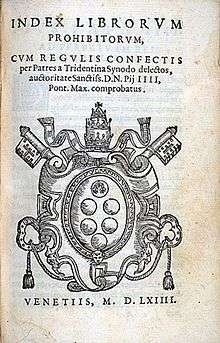
The Index Librorum Prohibitorum ("List of Prohibited Books") was a list of publications prohibited by the Catholic Church. The promulgation of the Index marked the "turning-point in the freedom of enquiry" in the Catholic world.[98] The first Index was published in 1559 by the Sacred Congregation of the Roman Inquisition. The last edition of the Index appeared in 1948 and publication of the list ceased 1966.[99]
The avowed aim of the list was to protect the faith and morals of the faithful by preventing the reading of immoral books or works containing theological errors. Books thought to contain such errors included some scientific works by leading astronomers such as Johannes Kepler's Epitome astronomiae Copernicianae, which was on the Index from 1621 to 1835. The various editions of the Index also contained the rules of the Church relating to the reading, selling and pre-emptive censorship of books.
Canon law still recommends that works concerning sacred Scripture, theology, canon law, church history, and any writings which specially concern religion or good morals, be submitted to the judgement of the local Ordinary.[100]
Some of the scientific works that were on early editions of the Index (e.g. on heliocentrism) have long been routinely taught at Catholic universities worldwide. Giordano Bruno, whose works were on the Index, now has a monument in Rome, erected over the Church's objections at the place where he was burned alive at the stake for heresy.
Protestant role in science
According to the Merton Thesis there was a positive correlation between the rise of puritanism and protestant pietism on the one hand and early experimental science on the other.[101] The Merton Thesis has two separate parts: Firstly, it presents a theory that science changes due to an accumulation of observations and improvement in experimental techniques and methodology; secondly, it puts forward the argument that the popularity of science in 17th-century England and the religious demography of the Royal Society (English scientists of that time were predominantly Puritans or other Protestants) can be explained by a correlation between Protestantism and the scientific values.[102] In his theory, Robert K. Merton focused on English Puritanism and German Pietism as having been responsible for the development of the scientific revolution of the 17th and 18th centuries. Merton explained that the connection between religious affiliation and interest in science was the result of a significant synergy between the ascetic Protestant values and those of modern science.[103] Protestant values encouraged scientific research by allowing science to study God's influence on the world and thus providing a religious justification for scientific research.[101]
Astronomy

Historically, the Catholic Church has been a major a sponsor of astronomy, not least due to the astronomical basis of the calendar by which holy days and Easter are determined. Nevertheless, the most famous case of a scientist being tried for heresy arose in this field of science: the trial of Galileo.
The Church's interest in astronomy began with purely practical concerns, when in the 16th century Pope Gregory XIII required astronomers to correct for the fact that the Julian calendar had fallen out of sync with the sky. Since the Spring equinox was tied to the celebration of Easter, the Church considered that this steady movement in the date of the equinox was undesirable. The resulting Gregorian calendar is the internationally accepted civil calendar used throughout the world today and is an important contribution of the Catholic Church to Western Civilisation.[104][105][106] It was introduced by Pope Gregory XIII, after whom the calendar was named, by a decree signed on 24 February 1582.[107] In 1789, the Vatican Observatory opened. It was moved to Castel Gandolfo in the 1930s and the Vatican Advanced Technology Telescope began making observation in Arizona, USA, in 1995.[108]


The famous astronomers Nicholas Copernicus, who put the sun at the centre of the heavens in 1543, and Galileo Galilei, who experimented with the new technology of the telescope and, with its aid declared his belief that Copernicus was correct – were both practising Catholics – indeed Copernicus was a catholic clergyman. Yet the church establishment at that time held to theories devised in pre-Christian Greece by Ptolemy and Aristotle, which said that the sky revolved around the earth. When Galileo began to assert that the earth in fact revolved around the sun, he therefore found himself challenging the Church establishment at a time where the Church hierarchy also held temporal power and was engaged in the ongoing political challenge of the rise of Protestantism. After discussions with Pope Urban VIII (a man who had written admiringly of Galileo before taking papal office), Galileo believed he could avoid censure by presenting his arguments in dialogue form – but the Pope took offence when he discovered that some of his own words were being spoken by a character in the book who was a simpleton and Galileo was called for a trial before the Inquisition.[109]
In this most famous example cited by critics of the Catholic Church's "posture towards science", Galileo Galilei was denounced in 1633 for his work on the heliocentric model of the solar system, previously proposed by the Polish clergyman and intellectual Nicolaus Copernicus. Copernicus's work had been suppressed de facto by the Church, but Catholic authorities were generally tolerant of discussion of the hypothesis as long as it was portrayed only as a useful mathematical fiction, and not descriptive of reality. Galileo, by contrast, argued from his unprecedented observations of the solar system that the heliocentric system was not merely an abstract model for calculating planetary motions, but actually corresponded to physical reality – that is, he insisted the planets really do orbit the Sun. After years of telescopic observation, consultations with the Popes, and verbal and written discussions with astronomers and clerics, a trial was convened by the Tribunal of the Roman and Universal Inquisition. Galileo was found "vehemently suspect of heresy" (not "guilty of heresy," as is frequently misreported), placed under house arrest, and all of his works, including any future writings, were banned.[110] Galileo had been threatened with torture and other Catholic scientists fell silent on the issue. Galileo's great contemporary René Descartes stopped publishing in France and went to Sweden. According to Polish-British historian of science Jacob Bronowski:[109]
| “ | The effect of the trial and imprisonment was to put a total stop to the scientific tradition in the Mediterranean. From now on the Scientific Revolution moved to Northern Europe. | ” |
Pope John Paul II, on 31 October 1992, publicly expressed regret for the actions of those Catholics who badly treated Galileo in that trial.[111][112] Cardinal John Henry Newman, in the nineteenth century, claimed that those who attack the Church can only point to the Galileo case, which to many historians does not prove the Church's opposition to science since many of the churchmen at that time were encouraged by the Church to continue their research.[113]
Evolution
Since the publication of Charles Darwin's On the Origin of Species in 1859, the position of the Catholic Church on the theory of evolution has slowly been refined. For about 100 years, there was no authoritative pronouncement on the subject, though many hostile comments were made by local church figures. In contrast with many Protestant objections, Catholic issues with evolutionary theory have had little to do with maintaining the literalism of the account in the Book of Genesis, and have always been concerned with the question of how man came to have a soul. Modern Creationism has had little Catholic support. In the 1950s, the Church's position was one of neutrality; by the late 20th century its position evolved to one of general acceptance in recent years. However, the church insists that the human soul was immediately infused by God, and the reality of a single ancestor (commonly called monogenism) for the human race.
Today, the Church's official position is a fairly non-specific example of theistic evolution,[114][115] stating that faith and scientific findings regarding human evolution are not in conflict, though humans are regarded as a special creation, and that the existence of God is required to explain both monogenism and the spiritual component of human origins. No infallible declarations by the Pope or an Ecumenical Council have been made. The official Church position is fairly non-specific, stating only that faith and the origin of man's material body "from pre-existing living matter" are not in conflict, and that the existence of God is required to explain the spiritual component of man's origin.
Many Christians, however, state that if the Biblical account of the creation of the world (as opposed to evolution) is not taken literally it undermines the entire validity of the Christian faith.[116]
Embryonic stem cell research
Recently, the Church has been criticized for its teaching that embryonic stem cell research is a form of experimentation on human beings, and results in the killing of a human person. Much criticism of this position has been on the grounds that the doctrine hinders scientific research; even some conservatives, taking a utilitarian position, have pointed out that most embryos from which stem cells are harvested are "leftover" from in vitro fertilization, and would soon be discarded whether used for such research or not. The Church, by contrast, has consistently upheld its ideal of the dignity of each individual human life, and argues that it is as wrong to destroy an embryo as it would be to kill an adult human being; and that therefore advances in medicine can and must come without the destruction of human embryos, for example by using adult or umbilical stem cells in place of embryonic stem cells.
Art, literature, and music
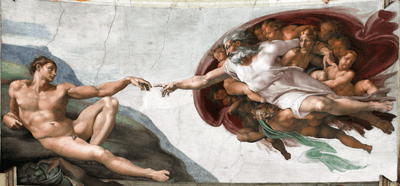
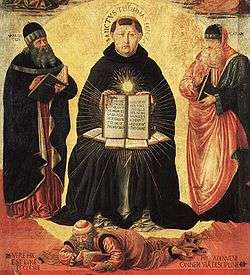
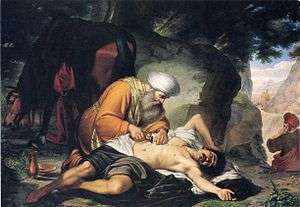

Many Eastern Orthodox states in Eastern Europe, as well as to some degree the Muslim states of the eastern Mediterranean, preserved many aspects of the empire's culture and art for centuries afterward. A number of states contemporary with the Byzantine Empire were culturally influenced by it, without actually being part of it (the "Byzantine commonwealth"). These included Bulgaria, Serbia, and the Rus, as well as some non-Orthodox states like the Republic of Venice and the Kingdom of Sicily, which had close ties to the Byzantine Empire despite being in other respects part of western European culture. Art produced by Eastern Orthodox Christians living in the Ottoman Empire is often called "post-Byzantine." Certain artistic traditions that originated in the Byzantine Empire, particularly in regard to icon painting and church architecture, are maintained in Greece, Serbia, Bulgaria, Macedonia, Russia and other Eastern Orthodox countries to the present day.
Several historians credit the Catholic Church for what they consider to be the brilliance and magnificence of Western art. They refer to the Church's consistent opposition to Byzantine iconoclasm, a movement against visual representations of the divine, and its insistence on building structures befitting worship. Important contributions include its cultivation and patronage of individual artists, as well as development of the Romanesque, Gothic and Renaissance styles of art and architecture.[117] Renaissance artists such as Raphael, Michelangelo, Leonardo da Vinci, Bernini, Botticelli, Fra Angelico, Tintoretto, Caravaggio, and Titian, were among a multitude of innovative virtuosos sponsored by the Church.[118] Augustine's repeated reference to Wisdom 11:20 (God "ordered all things by measure and number and weight") influenced the geometric constructions of Gothic architecture, the scholastics' intellectual systems called the Summa Theologiae which influenced the writings of Dante, its creation and sacramental theology which has developed a Catholic imagination influencing writers such as J. R. R. Tolkien[119] and William Shakespeare,[120] and of course, the patronage of the Renaissance popes for the great works of Catholic artists such as Michelangelo, Raphael, Bernini, Borromini and Leonardo da Vinci.
British art historian Kenneth Clark wrote that Western Europe's first "great age of civilisation" was ready to begin around the year 1000. From 1100, he wrote, monumental abbeys and cathedrals were constructed and decorated with sculptures, hangings, mosaics and works belonging one of the greatest epochs of art and providing stark contrast to the monotonous and cramped conditions of ordinary living during the period. Abbot Suger of the Abbey of St. Denis is considered an influential early patron of Gothic architecture and believed that love of beauty brought people closer to God: "The dull mind rises to truth through that which is material". Clarke calls this "the intellectual background of all the sublime works of art of the next century and in fact has remained the basis of our belief of the value of art until today".[23]
Later, during The Renaissance and Counter-Reformation, Catholic artists produced many of the unsurpassed masterpieces of Western art – often inspired by Biblical themes: from Michelangelo's David and Pietà sculptures, to Da Vinci's Last Supper and Raphael's various Madonna paintings. Referring to a "great outburst of creative energy such as took place in Rome between 1620 and 1660", Kenneth Clarke wrote:[23]
[W]ith a single exception, the great artists of the time were all sincere, conforming Christians. Guercino spent much of his mornings in prayer; Bernini frequently went into retreats and practised the Spiritual Exercises of Saint Ignatius; Rubens attended Mass every morning before beginning work. The exception was Caravaggio, who was like the hero of a modern play, except that he happened to paint very well. This conformism was not based on fear of the Inquisition, but on the perfectly simple belief that the faith which had inspired the great saints of the preceding generation was something by which a man should regulate his life.
In music, Catholic monks developed the first forms of modern Western musical notation in order to standardize liturgy throughout the worldwide Church,[121] and an enormous body of religious music has been composed for it through the ages. This led directly to the emergence and development of European classical music, and its many derivatives. The Baroque style, which encompassed music, art, and architecture, was particularly encouraged by the post-Reformation Catholic Church as such forms offered a means of religious expression that was stirring and emotional, intended to stimulate religious fervor.[122]
The list of Catholic composers and Catholic sacred music which have a prominent place in Western culture is extensive, but includes Ludwig van Beethoven's Ode to Joy; Wolfgang Amadeus Mozart's Ave Verum Corpus; Franz Schubert's Ave Maria, César Franck's Panis Angelicus, and Antonio Vivaldi's Gloria.
Similarly, the list of Catholic authors and literary works is vast. With a literary tradition spanning two millennia, the Bible and Papal Encyclicals have been constants of the Catholic canon but countless other historical works may be listed as noteworthy in terms of their influence on Western society. From late Antiquity, St Augustine's book Confessions, which outlines his sinful youth and conversion to Christianity, is widely considered to be the first autobiography of ever written in the canon of Western Literature. Augustine profoundly influenced the coming medieval worldview.[88] The Summa Theologica, written 1265–1274, is the best-known work of Thomas Aquinas (c.1225–1274), and although unfinished, "one of the classics of the history of philosophy and one of the most influential works of Western literature."[123] It is intended as a manual for beginners in theology and a compendium of all of the main theological teachings of the Church. It presents the reasoning for almost all points of Christian theology in the West. The epic poetry of the Italian Dante and his Divine Comedy of the late Middle Ages is also considered immensely influential. The English statesman and philosopher, Thomas More, wrote the seminal work Utopia in 1516. St Ignatius Loyola, a key figure in the Catholic counter-reformation, is the author of an influential book of meditations known as the Spiritual Exercises.
In Catholicism, "Doctor of the Church" is a name is given to a saint from whose writings the whole Church is held to have derived great advantage and to whom "eminent learning" and "great sanctity" have been attributed by a proclamation of a pope or of an ecumenical council. This honour is given rarely, and only after canonization.
The arts have been strongly inspired by Protestant beliefs. Martin Luther, Paul Gerhardt, George Wither, Isaac Watts, Charles Wesley, William Cowper, and many other authors and composers created well-known church hymns. Musicians like Heinrich Schütz, Johann Sebastian Bach, George Frederick Handel, Henry Purcell, Johannes Brahms, and Felix Mendelssohn-Bartholdy composed great works of music. Prominent painters with Protestant background were, for example, Albrecht Dürer, Hans Holbein the Younger, Lucas Cranach, Rembrandt, and Vincent van Gogh. World literature was enriched by the works of Edmund Spenser, John Milton, John Bunyan, John Donne, John Dryden, Daniel Defoe, William Wordsworth, Jonathan Swift, Johann Wolfgang Goethe, Friedrich Schiller, Samuel Taylor Coleridge, Edgar Allan Poe, Matthew Arnold, Conrad Ferdinand Meyer, Theodor Fontane, Washington Irving, Robert Browning, Emily Dickinson, Emily Brontë, Charles Dickens, Nathaniel Hawthorne, Thomas Stearns Eliot, John Galsworthy, Thomas Mann, William Faulkner, John Updike, and many others.
Economic development
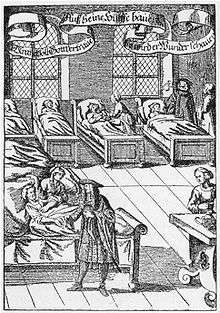
Francisco de Vitoria, a disciple of Thomas Aquinas and a Catholic thinker who studied the issue regarding the human rights of colonized natives, is recognized by the United Nations as a father of international law, and now also by historians of economics and democracy as a leading light for the West's democracy and rapid economic development.[124]
Joseph Schumpeter, an economist of the twentieth century, referring to the Scholastics, wrote, "it is they who come nearer than does any other group to having been the 'founders' of scientific economics."[125] Other economists and historians, such as Raymond de Roover, Marjorie Grice-Hutchinson, and Alejandro Chafuen, have also made similar statements. Historian Paul Legutko of Stanford University said the Catholic Church is "at the center of the development of the values, ideas, science, laws, and institutions which constitute what we call Western civilization."[126]
Protestant work ethic
The Protestant concept of God and man allows believers to use all their God-given faculties, including the power of reason. That means that they are allowed to explore God's creation and, according to Genesis 2:15, make use of it in a responsible and sustainable way. Thus a cultural climate was created that greatly enhanced the development of the humanities and the sciences.[127] Another consequence of the Protestant understanding of man is that the believers, in gratitude for their election and redemption in Christ, are to follow God's commandments. Industry, frugality, calling, discipline, and a strong sense of responsibility are at the heart of their moral code.[128][129] In particular, Calvin rejected luxury. Therefore, craftsmen, industrialists, and other businessmen were able to reinvest the greater part of their profits in the most efficient machinery and the most modern production methods that were based on progress in the sciences and technology. As a result, productivity grew, which led to increased profits and enabled employers to pay higher wages. In this way, the economy, the sciences, and technology reinforced each other. The chance to participate in the economic success of technological inventions was a strong incentive to both inventors and investors.[130][131][132][133] The Protestant work ethic was an important force behind the unplanned and uncoordinated mass action that influenced the development of capitalism and the industrial revolution. This idea is also known as the "Protestant ethic thesis."[134]
Episcopalians and Presbyterians tend to be considerably wealthier[135] and better educated (having more graduate and post-graduate degrees per capita) than most other religious groups in America,[136] and are disproportionately represented in the upper reaches of American business,[137] law and politics, especially the Republican Party.[138] Large numbers of the most wealthy and affluent American families as the Vanderbilts and Astors, Rockefeller, Du Pont, Roosevelt, Forbes, Whitneys, the Morgans and Harrimans are Mainline Protestant families.[135]
Social justice, care-giving, and the hospital system
The Catholic Church has contributed to society through its social doctrine which has guided leaders to promote social justice and providing care to the sick and poor. In orations such as his Sermon on the Mount and stories such as The Good Samaritan, Jesus called on followers to worship God, act without violence or prejudice and care for the sick, hungry and poor. Such teachings are the foundation of Catholic Church involvement in social justice, hospitals and health care.
Medieval period
The Catholic Church established a hospital system in Medieval Europe that was different from the merely reciprocal hospitality of the Greeks and family-based obligations of the Romans. These hospitals were established to cater to "particular social groups marginalized by poverty, sickness, and age," according to historian of hospitals, Guenter Risse.[139]
Industrial Revolution


The Industrial Revolution brought many concerns about the deteriorating working and living conditions of urban workers. Influenced by the German Bishop Wilhelm Emmanuel Freiherr von Ketteler, in 1891 Pope Leo XIII published the encyclical Rerum novarum, which set in context Catholic social teaching in terms that rejected socialism but advocated the regulation of working conditions. Rerum Novarum argued for the establishment of a living wage and the right of workers to form trade unions.[140]
Quadragesimo anno was issued by Pope Pius XI, on 15 May 1931, 40 years after Rerum novarum. Unlike Leo, who addressed mainly the condition of workers, Pius XI concentrated on the ethical implications of the social and economic order. He called for the reconstruction of the social order based on the principle of solidarity and subsidiarity.[141] He noted major dangers for human freedom and dignity, arising from unrestrained capitalism and totalitarian communism.
The social teachings of Pope Pius XII repeat these teachings, and apply them in greater detail not only to workers and owners of capital, but also to other professions such as politicians, educators, house-wives, farmers bookkeepers, international organizations, and all aspects of life including the military. Going beyond Pius XI, he also defined social teachings in the areas of medicine, psychology, sport, TV, science, law and education. Pius XII was called "the Pope of Technology for his willingness and ability to examine the social implications of technological advances. The dominant concern was the continued rights and dignity of the individual. With the beginning of the space age at the end of his pontificate, Pius XII explored the social implications of space exploration and satellites on the social fabric of humanity asking for a new sense of community and solidarity in light of existing papal teachings on subsidiarity.[142]
The Methodist Church, among other Christian denominations, was responsible for the establishment of hospitals, universities, orphanages, soup kitchens, and schools to follow Jesus's command to spread the Good News and serve all people.[143][144] In Western nations, governments have increasingly taken up funding and organisation of health services for the poor but the Church still maintains a massive network of health care providers across the world. In the West, these institutions are increasingly run by lay-people after centuries of being run by priests, nuns and brothers, In 2009, Catholic hospitals in the USA received approximately one of every six patients, according to the Catholic Health Association.[145] Catholic Health Australia is the largest non-government provider grouping of health, community and aged care services, representing about 10% of the health sector.[146] In 1968, nuns or priests were the chief executives of 770 of America's 796 Catholic hospitals. By 2011, they presided over 8 of 636 hospitals.[145]
As with schooling, women have played a vital role in running and staffing Christian care institutions – in Methodist hospitals, deaconesses who trained as nurses staffed the hospitals,[144] and in Catholic hospitals, through religious institutes like the Sisters of Mercy, Little Sisters of the Poor and Sisters of St. Mary – and teaching and nursing have been seen as "women's vocations". Seeking to define the role played by religious in hospitals through American history, the New York Times noted that nuns were trained to "see Jesus in the face of every patient" and that:[145]
| “ | Although their influence is often described as intangible, the nuns kept their hospitals focused on serving the needy and brought a spiritual reassurance that healing would prevail over profit, authorities on Catholic health care say. | ” |
Education
| Institutions | # |
|---|---|
| Parishes and missions | 408,637 |
| Primary and secondary schools | 125,016 |
| Universities | 1,046 |
| Hospitals | 5,853 |
| Orphanages | 8,695 |
| Homes for the elderly and handicapped | 13,933 |
| Dispensaries, leprosaries, nurseries and other institutions | 74,936 |
Missionary activity for the Catholic Church has always incorporated education of evangelized peoples as part of its social ministry. History shows that in evangelized lands, the first people to operate schools were Roman Catholics. In some countries, the Church is the main provider of education or significantly supplements government forms of education. Presently, the Church operates the world's largest non-governmental school system.[148] Many of Western Civilization's most influential universities were founded by the Catholic Church.
Europe
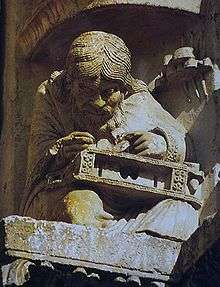
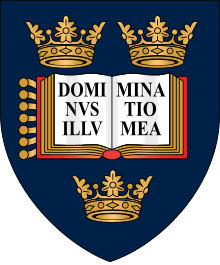
The Catholic Church founded the West's first universities, which were preceded by the schools attached to monasteries and cathedrals, and generally staffed by monks and friars.[149]
In 530, Saint Benedict wrote his monastic Rule, which became a blueprint for the organization of monasteries throughout Europe.[150] The new monasteries preserved classical craft and artistic skills while maintaining intellectual culture within their schools, scriptoria and libraries. As well as providing a focus for spiritual life, they functioned as agricultural, economic and production centers, particularly in remote regions, becoming major conduits of civilization.[151]
The Cluniac reform of monasteries that had begun in 910 sparked widespread monastic growth and renewal.[152] Monasteries introduced new technologies and crops, fostered the creation and preservation of literature and promoted economic growth. Monasteries, convents and cathedrals still operated virtually all schools and libraries.[153][154]
Cathedral schools began in the Early Middle Ages as centers of advanced education, some of them ultimately evolving into medieval universities. During the High Middle Ages, Chartres Cathedral operated the famous and influential Chartres Cathedral School.
Universities began springing up in Italian towns like Salerno, which became a leading medical school, translating the work of Greek and Arabic physicians into Latin. Bologna University became the most influential of the early universities, which first specialised in canon law and civil law. Paris University, specialising in such topics as theology, came to rival Bologna under the supervision of Notre Dame Cathedral. Oxford University in England later came rival Paris in Theology and Salamanca University was founded in Spain in 1243. According to the historian Geoffrey Blainey, the universities benefitted from the use of Latin, the common language of the Church, and its internationalist reach, and their role was to "teach, argue and reason within a Christian framework".[149] The medieval universities of Western Christendom were well-integrated across all of Western Europe, encouraged freedom of enquiry and produced a great variety of fine scholars and natural philosophers, including Robert Grosseteste of the University of Oxford, an early expositor of a systematic method of scientific experimentation;[155] and Saint Albert the Great, a pioneer of biological field research[156]
In the 13th century, mendicant orders were founded by Francis of Assisi and Dominic de Guzmán which brought consecrated religious life into urban settings.[157] These orders also played a large role in the development of cathedral schools into universities, the direct ancestors of the modern Western institutions.[158] Notable scholastic theologians such as the Dominican Thomas Aquinas worked at these universities, his Summa Theologica was a key intellectual achievement in its synthesis of Aristotelian thought and Christianity.[159]
The university reached central Europe by the 14th century, with the foundation of institutions like Prague University and Cracow University.
The Spaniard St Ignatius Loyola founded the Society of Jesus (Jesuits) in 1540. Initially a missionary order, the Jesuits took Western learning and the Catholic faith to India, Japan, China, Canada, Central and South America and Australia.[160] The order became increasingly involved in education, founding schools, colleges and universities across the globe and educating such notable Western scholars, intellectuals, artists and statesmen as René Descartes, Matteo Ricci, Voltaire, Pierre de Coubertin, Sir Arthur Conan Doyle, James Joyce, Alfred Hitchcock, Bing Crosby, Robert Hughes and Bill Clinton.
According to the historian Geoffrey Blainey, the university became a hallmark of Christian Civilisation, though, he writes, "in the most recent century perhaps no institution has done more to promote an alternative or secular view of the world".[149]
Latin America
Education in Latin American began under the direction of missionaries who were sponsored by the Spanish crown. Royal policy stipulated that the Amerindians had to accept missionaries but they did not have to convert. Indians who agreed to listen to the missionaries were not subjected to work for encomenderos some of whom were notorious for brutal conditions.[161]
North America
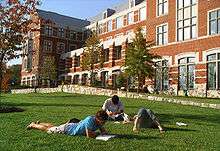
A number of Catholic universities, schools and colleges have been formed in the United States. The religious tolerance established by the American Revolution enabled the Catholic clergy of Maryland to found Georgetown University, America's oldest Catholic university, in 1789 and it became a Jesuit institution in 1805.[162] Saint Katharine Drexel inherited a fortune and established the Sisters of the Blessed Sacrament for Indians and Colored People (now known as the Sisters of the Blessed Sacrament), founded schools across America and started Xavier University of Louisiana in New Orleans in 1925 for the education of African Americans.[163]
Australasia
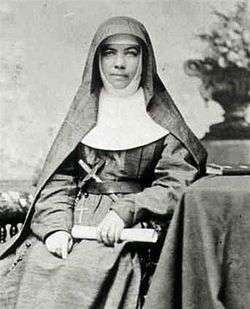
From 19th century foundations, the Catholic education system in Australia has grown to be the second biggest sector after government schools with around 21 per cent of all secondary school enrolments.[164] The Church has established primary, secondary and tertiary educational institutions. St Mary MacKillop was a 19th-century Australian nun who founded an educational religious institute, the Sisters of St Joseph of the Sacred Heart, and in 2010 became the first Australian to be canonised as a saint.[165] Catholic education is also significant in neighbouring South Pacific nations: 11% of New Zealand students attend Catholic schools[166]
Africa
By the close of the 19th century, European powers had managed to gain control of most of the African interior.[74] The new rulers introduced cash-based economies which created an enormous demand for literacy and a western education—a demand which for most Africans could only be satisfied by Christian missionaries.[74] Catholic missionaries followed colonial governments into Africa, and built schools, hospitals, monasteries and churches.[74]
With a high number of adult baptisms, the Church is growing faster in Africa than anywhere else.[167] It also operates a greater number of Catholic schools per parish here (3:1) than in other areas of the world.[168]
Asia
In India, over 25,000 schools and colleges are operated by the Church.[169]
Protestant role in education

As the Reformers wanted all members of the church to be able to read the Bible, education on all levels got a strong boost. Compulsory education for both boys and girls was introduced. For example, the Puritans who established Massachusetts Bay Colony in 1628 founded Harvard College only eight years later. About a dozen other colleges followed in the 18th century, including Yale University (1701). Pennsylvania also became a centre of learning.[170][171] Protestantism also initiated translations of the Bible into national languages and hereby supported the development of national literatures.
A large number of mainline Protestants have played leadership roles in many aspects of American life, including politics, business, science, the arts, and education. They founded most of the country's leading institutes of higher education.[172] Princeton was a Presbyterian foundation.
See also
References
- ↑ Brooke, John H.; Numbers, Ronald L., eds. (2011). Science and Religion Around the World. New York: Oxford University Press. p. 71. ISBN 978-0-195-32819-6.
- ↑ Johnson, P. (2000). The Renaissance : a short history. Modern Library chronicles (Modern Library ed.). New York: Modern Library, p. 9.
- ↑ Rüegg, Walter: "Foreword. The University as a European Institution", in: A History of the University in Europe. Vol. 1: Universities in the Middle Ages, Cambridge University Press, 1992, ISBN 0-521-36105-2, pp. XIX–XX
- ↑ Verger 1999
- ↑ Chadwick, Owen p. 242.
- ↑ Hastings, p. 309.
- ↑ Stark, p. 104.
- ↑ Kreeft, p. 61.
- ↑ Bokenkotter, p. 465
- 1 2 BBC, BBC—Religion & Ethics—566, Christianity
- 1 2 Geoffrey Blainey; A Very Short History of the World; Penguin Books, 2004
- ↑ Religion in the Roman Empire, Wiley-Blackwell, by James B. Rives, page 196
- ↑ Wikisource:Catholic Encyclopedia (1913)/St. Ambrose
- ↑ "CATHOLIC ENCYCLOPEDIA: Theodosius I".
- ↑ "CATHOLIC ENCYCLOPEDIA: St. Gregory the Great".
- ↑ Geoffrey Blainey; A Short History of Christianity; Penguin Viking; 2011; pp 214–215.
- 1 2 3 Witte (1997), p. 23.
- ↑ Witte (1997), p. 30.
- ↑ Witte (1997), p. 31.
- ↑ Power, p 1.
- ↑ Kenneth Clarke; Civilisation, BBC, SBN 563 10279 9; first published 1969.
- ↑ http://www.newadvent.org/cathen/01007e.htm (Montalembert, "The Monks of the West," Bk. XV.)
- 1 2 3 Kenneth Clarke; Civilisation, BBC, SBN 563 10279 9; first published 1969.
- ↑ "Catholic Encyclopedia: Frederick Ii". Newadvent.org. 1 September 1909. Retrieved 16 July 2011.
- ↑ Morris, Colin, The papal monarchy: the Western church from 1050 to 1250 , (Oxford University Press, 2001), 271.
- ↑ Heinrich Bornkamm, Toleranz. In der Geschichte des Christentums in Die Religion in Geschichte und Gegenwart, 3. Auflage, Band VI (1962), col. 937
- ↑ Original German title: Dass eine christliche Versammlung oder Gemeine Recht und Macht habe, alle Lehre zu beurteilen und Lehrer zu berufen, ein- und abzusetzen: Grund und Ursach aus der Schrift
- ↑ Clifton E. Olmstead, History of Religion in the United States, pp. 4–10
- ↑ Karl Heussi, Kompendium der Kirchengeschichte, 11. Auflage, p. 325
- ↑ Quoted in Jan Weerda, Calvin, in Evangelisches Soziallexikon, 3. Auflage (1958), Stuttgart (Germany), col. 210
- ↑ Clifton E. Olmstead, History of Religion in the United States, p. 10
- ↑ Karl Heussi, Kompendium der Kirchengeschichte, S. 396–397
- ↑ Cf. M. Schmidt, England. Kirchengeschichte, in Die Religion in Geschichte und Gegenwart, 3. Auflage, Band II (1959), Tübingen (Germany), col. 476–478
- ↑ Nathaniel Philbrick (2006), Mayflower: A Story of Courage, Community, and War, Penguin Group, New York, N.Y., ISBN 0-670-03760-5
- ↑ Clifton E. Olmstead, History of Religion in the United States, pp. 65–76
- ↑ Christopher Fennell (1998), Plymouth Colony Legal Structure, (http://www.histarch.uiuc.edu/plymouth/ccflaw.html)
- ↑ Hanover Historical Texts Project (http://history.hanover.edu/texts/masslib.html)
- ↑ M. Schmidt, Pilgerväter, in Die Religion in Geschichte und Gegenwart, 3. Auflage, Band V (1961), col. 384
- ↑ Christopher Fennell, Plymouth Colony Legal Structure
- ↑ Allen Weinstein and David Rubel (2002), The Story of America: Freedom and Crisis from Settlement to Superpower, DK Publishing, Inc., New York, N.Y., ISBN 0-7894-8903-1, p. 61
- 1 2 3 Witte (1997), p. 20.
- ↑ Power (1995), pp. 1–2.
- ↑ "CATHOLIC ENCYCLOPEDIA: Sacrament of Marriage".
- 1 2 Feige, Diana, and Franz G M. Feige. "Love, Marriage, and Family in Puritan Society." Dialogue & Alliance 9, no. 1 (1 March 1995): 96–114. ATLA Religion Database with ATLASerials, EBSCOhost (accessed 3 December 2010). P109
- 1 2 "The no-sex 'myth'". BBC News. 3 October 2002.
- 1 2 Noble, p.230
- 1 2 Stark, p.104
- ↑ Nathan (2002), p. 187.
- ↑ Nathan (2002), p. 91.
- ↑ Power (1995), pp. 1–2.
- ↑ Shahar (2003), p. 33.
- ↑ Witte (1997), p. 29, 36
- ↑ Witte (1997), p. 20, 25
- ↑ Shahar (2003), p. 18.
- ↑ Shahar (2003), p. 88. "The ecclesiastical conception of the inferior status of women, deriving from Creation, her role in Original Sin and her subjugation to man, provided both direct and indirect justification for her inferior standing in the family and in society in medieval civilization. It was not the Church which induced husbands to beat their wives, but it not only accepted this custom after the event, if it was not carried to excess, but, by proclaiming the superiority of man, also supplied its moral justification."
- ↑ Shahar (2003), p. 12.
- ↑ Power (1995), p. 2.
- ↑ Shahar (2003), p. 25.
- ↑ Bitel (2002), p. 102.
- ↑ Nathan (2002), pp. 171–173.
- ↑ Stark, Rodney (1 July 2003). "The Truth About the Catholic Church and Slavery". Christianity Today.
- ↑ "IN SUPREMO APOSTOLATUS".
- ↑ Stearns, p.65
- ↑ Woods, p. 135.
- ↑ Johansen, p. 109, 110, quote: "In the Americas, the Catholic priest Bartolome de las Casas avidly encouraged enquiries into the Spanish conquest's many cruelties. Las Casas chronicled Spanish brutality against the Native peoples in excruciating detail."
- ↑ Koschorke, p.287
- ↑ Woods, p. 137.
- ↑ Dussel, p. 45, 52, 53 quote: "The missionary Church opposed this state of affairs from the beginning, and nearly everything positive that was done for the benefit of the indigenous peoples resulted from the call and clamor of the missionaries. The fact remained, however, that widespread injustice was extremely difficult to uproot ... Even more important than Bartolome de Las Casas was the Bishop of Nicaragua, Antonio de Valdeviso, who ultimately suffered martyrdom for his defense of the Indian."
- ↑ Johansen, p. 110, quote: "In the Papal bull Sublimis deus (1537), Pope Paul III declared that Indians were to be regarded as fully human, and that their souls were as immortal as those of Europeans. This edict also outlawed slavery of Indians in any form ..."
- ↑ Noble, p. 454.
- ↑ Ferro, p. 221.
- ↑ Thomas, p. 65-6.
- ↑ Duffy, p. 221.
- 1 2 3 4 5 6 Hastings, p. 397–410.
- ↑ "J.L. Heilbron". London Review of Books. Retrieved 15 September 2006.
- ↑ Lindberg, David C.; Numbers, Ronald L. (October 2003). When Science and Christianity Meet. University of Chicago Press. ISBN 0-226-48214-6.
- ↑ Goldstein, Thomas (April 1995). Dawn of Modern Science: From the Ancient Greeks to the Renaissance. Da Capo Press. ISBN 0-306-80637-1.
- ↑ Pope John Paul II (September 1998). "Fides et Ratio (Faith and Reason), IV". Retrieved 15 September 2006.
- ↑ Pro forma candidate to Prince-Bishop of Warmia, cf. Dobrzycki, Jerzy, and Leszek Hajdukiewicz, "Kopernik, Mikołaj", Polski słownik biograficzny (Polish Biographical Dictionary), vol. XIV, Wrocław, Polish Academy of Sciences, 1969, p. 11.
- ↑ Sharratt, Michael (1994). Galileo: Decisive Innovator. Cambridge: Cambridge University Press. pp. 17, 213. ISBN 0-521-56671-1.
- ↑ "Because he would not accept the Formula of Concord without some reservations, he was excommunicated from the Lutheran communion. Because he remained faithful to his Lutheranism throughout his life, he experienced constant suspicion from Catholics." John L. Treloar, "Biography of Kepler shows man of rare integrity. Astronomer saw science and spirituality as one." National Catholic Reporter, 8 October 2004, p. 2a. A review of James A. Connor Kepler's Witch: An Astronomer's Discovery of Cosmic Order amid Religious War, Political Intrigue and Heresy Trial of His Mother, Harper San Francisco.
- ↑ Richard S. Westfall – Indiana University The Galileo Project. (Rice University). Retrieved 2008-07-05.
- ↑ "The Boyle Lecture". St. Marylebow Church.
- ↑ Baruch A. Shalev, 100 Years of Nobel Prizes (2003),Atlantic Publishers & Distributors , p.57: between 1901 and 2000 reveals that 654 Laureates belong to 28 different religion Most 65.4% have identified Christianity in its various forms as their religious preference.
- 1 2 3 4 5 Shalev, Baruch (2005). 100 Years of Nobel Prizes. p. 59
- ↑ "Bona, Algeria". World Digital Library. 1899. Retrieved 2013-09-25.
- ↑ Durant, Will (1992). Caesar and Christ: a History of Roman Civilization and of Christianity from Their Beginnings to A.D. 325. New York: MJF Books. ISBN 1-56731-014-1.
- 1 2 Wilken, Robert L. (2003). The Spirit of Early Christian Thought. New Haven: Yale University Press. p. 291. ISBN 0-300-10598-3.
- ↑ Anastos 1962, p. 409.
- ↑ Alexander Jones, "Book Review, Archimedes Manuscript" American Mathematical Society, May 2005.
- ↑ King 1991, pp. 116–118.
- ↑ Cohen 1994, p. 395; Dickson, Mathematics Through the Middle Ages.
- ↑ Robins 1993, p. 8.
- ↑ Tatakes & Moutafakis 2003, p. 189.
- ↑ Troianos & Velissaropoulou-Karakosta 1997, p. 340
- 1 2 Kenneth Clark; Civilisation, BBC, SBN 563 10279 9; first published 1969
- ↑ How The Irish Saved Civilization: The Untold Story of Ireland's Heroic Role from the Fall of Rome to the Rise of Medieval Europe by Thomas Cahill, 1995.
- ↑ Charles B. Schmitt, et al. The Cambridge History of Renaissance Philosophy (Cambridge University Press, 1991), "Printing and censorship after 1550", p.45ff.
- ↑ "Index Librorum Prohibitorum". Encyclopedia Britannica.
- ↑ "Code of Canon Law: text – IntraText CT".
- 1 2 Sztompka, Piotr (2003), Robert King Merton, in Ritzer, George, The Blackwell Companion to Major Contemporary Social Theorists, Malden, Massachusetts Oxford: Blackwell, p. 13, ISBN 9781405105958
- ↑ Gregory, Andrew (1998), Handout for course 'The Scientific Revolution' at The Scientific Revolution
- ↑ Becker, George (1992), The Merton Thesis: Oetinger and German Pietism, a significant negative case, Sociological Forum (Springer) 7 (4), pp. 642–660
- ↑ Introduction to Calendars. United States Naval Observatory. Retrieved 15 January 2009.
- ↑ Calendars by L. E. Doggett. Section 2.
- ↑ The international standard for the representation of dates and times ISO 8601 uses the Gregorian calendar. Section 3.2.1.
- ↑ See Wikisource English translation of the (Latin) 1582 papal bull 'Inter gravissimas' instituting Gregorian calendar reform.
- ↑ Johnson, George (23 June 2009). "Vatican's Celestial Eye, Seeking Not Angels but Data". The New York Times.
- 1 2 Jacob Bronowski; The Ascent of Man; Angus & Robertson, 1973 ISBN 0-563-17064-6
- ↑ Drake (1978, p.367), Sharratt (1994, p.184), Favaro (1905, 16:209, 230)(Italian). When Fulgenzio Micanzio, one of Galileo's friends in Venice, sought to have Galileo's Discourse on Floating Bodies reprinted in 1635, he was informed by the Venetian Inquisitor that the Inquisition had forbidden further publication of any of Galileo's works (Favaro, 1905, 16:209)(Italian), and was later shown a copy of the order (Favaro,1905, 16:230).(Italian) When the Dutch publishers Elzevir published Galileo's Dialogues Concerning Two New Sciences in 1638, some five years after his trial, they did so under the pretense that a manuscript he had presented to the French Ambassador to Rome for preservation and circulation to interested intellectuals had been used without his knowledge (Sharratt, 1994, p.184; Galilei, 1954 p.xvii; Favaro, 1898, 8:43 (Italian)). Return to other article: Galileo Galilei ; Dialogue ; Two New Sciences.
- ↑ Choupin, Valeur des Decisions Doctrinales du Saint Siege
- ↑ An abstract of the acts of the process against Galileo is available at the Vatican Secret Archives, which reproduces part of it on its website.
- ↑ "How the Catholic Church Built Western Civilization". Catholic Education Resource Center. May 2005.
- ↑ Catholic Answers (Imprimatur Robert H. Brom, Bishop of San Diego). "Adam, Eve, and Evolution". Catholic Answers. Catholic.com. Retrieved 10 October 2007.
- ↑ Warren Kurt VonRoeschlaub. "God and Evolution". Talk Origins Archive. Retrieved 10 October 2007.
- ↑ "Do I have to believe in a literal creation to be a Christian?".
- ↑ Woods, pp. 115–27.
- ↑ Duffy, p. 133.
- ↑ Boffetti, Jason (November 2001). "Tolkien's Catholic Imagination". Crisis Magazine. Morley Publishing Group.
- ↑ Voss, Paul J. (July 2002). "Assurances of faith: How Catholic Was Shakespeare? How Catholic Are His Plays?". Crisis Magazine. Morley Publishing Group.
- ↑ Hall, p. 100.
- ↑ Murray, p. 45.
- ↑ Ross, James F., "Thomas Aquinas, Summa theologiae (ca. 1273), Christian Wisdom Explained Philosophically", in The Classics of Western Philosophy: A Reader's Guide, (eds.) Jorge J. E. Gracia, Gregory M. Reichberg, Bernard N. Schumacher (Oxford: Blackwell Publishing, 2003), p. 165.
- ↑ de Torre, Fr. Joseph M. (1997). "A Philosophical and Historical Analysis of Modern Democracy, Equality, and Freedom Under the Influence of Christianity". Catholic Education Resource Center.
- ↑ Schumpeter, Joseph (1954). History of Economic Analysis. London: Allen & Unwin.
- ↑ "Review of How the Catholic Church Built Western Civilization by Thomas Woods, Jr.". National Review Book Service. Retrieved 16 September 2006.
- ↑ Gerhard Lenski (1963), The Religious Factor: A Sociological Study of Religion's Impact on Politics, Economics, and Family Life, Revised Edition, A Doubleday Anchor Book, Garden City, N.Y., pp.348–351
- ↑ Cf. Robert Middlekauff (2005), The Glorious Cause: The American Revolution, 1763–1789, Revised and Expanded Edition, Oxford University Press, ISBN 978-0-19-516247-9, p. 52
- ↑ Jan Weerda, Soziallehre des Calvinismus, in Evangelisches Soziallexikon, 3. Auflage (1958), Stuttgart (Germany), col. 934
- ↑ Eduard Heimann, Kapitalismus, in Die Religion in Geschichte und Gegenwart, 3. Auflage, Band III (1959), Tübingen (Germany), col. 1136–1141
- ↑ Hans Fritz Schwenkhagen, Technik, in Evangelisches Soziallexikon, 3. Auflage, col. 1029–1033
- ↑ Georg Süßmann, Naturwissenschaft und Christentum, in Die Religion in Geschichte und Gegenwart, 3. Auflage, Band IV, col. 1377–1382
- ↑ C. Graf von Klinckowstroem, Technik. Geschichtlich, in Die Religion in Geschichte und Gegenwart, 3. Auflage, Band VI, col. 664–667
- ↑ Kim, Sung Ho (Fall 2008). "Max Weber". The Stanford Encyclopedia of Philosophy. Metaphysics Research Lab, CSLI, Stanford University. Retrieved 21 August 2011.
- 1 2 B.DRUMMOND AYRES Jr. (19 December 2011). "THE EPISCOPALIANS: AN AMERICAN ELITE WITH ROOTS GOING BACK TO JAMESTOWN". New York Times. Retrieved 2012-08-17.
- ↑ Irving Lewis Allen, "WASP—From Sociological Concept to Epithet," Ethnicity, 1975 154+
- ↑ Hacker, Andrew (1957). "Liberal Democracy and Social Control". American Political Science Review. 51 (4): 1009–1026 [p. 1011]. JSTOR 1952449.
- ↑ Baltzell (1964). The Protestant Establishment. p. 9.
- ↑ Risse, Guenter B (April 1999). Mending Bodies, Saving Souls: A History of Hospitals. Oxford University Press. p. 59. ISBN 0-19-505523-3.
- ↑ Duffy, Saints and Sinners (1997), p. 240
- ↑ Duffy 260
- ↑ Felictity O'Brien, Pius XII, London 2000, p.13
- ↑ Models for Christian Higher Education: Strategies for Survival and Success in the Twenty-First Century. William B. Eerdmans Publishing Company. Retrieved 18 October 2007.
Wesleyan institutions, whether hospitals, orphanages, soup kitchens, or schools, historically were begun with the spirit to serve all people and to transform society.
- 1 2 Teasdale, Mark R. (17 March 2014). Methodist Evangelism, American Salvation: The Home Missions of the Methodist Episcopal Church, 1860–1920. Wipf and Stock Publishers. p. 203. ISBN 9781620329160.
The new view of evangelism called for the denomination to undertake two new forms of activities: humanitarian aid and social witness. Humanitarian aid went beyond the individual help that many home missionaries were already providing to people within their care. It involved creating new structures that would augment the political, economic, and social systems so that those systems might be more humane. It included the establishment of Methodist hospitals in all the major cities in the United States. These hospitals were required to provide the best treatment possible free of charge to all who needed it, and were often staffed by deaconesses who trained as nurses. Homes for the aged and orphanages were also part of this work.
- 1 2 3 http://www.nytimes.com/2011/08/21/us/21nuns.html?pagewanted=2&_r=2&smid=fb-nytimes Nuns, a ‘Dying Breed,’ Fade From Leadership Roles at Catholic Hospitals, New York Times, 20.8.11
- ↑ http://www.cha.org.au/site.php?id=24
- ↑ Froehle, p. 17–20, p. 30–35, p. 41–43.
- ↑ Gardner, p. 148
- 1 2 3 Geoffrey Blainey; A Short History of Christianity; Penguin Viking; 2011
- ↑ Woods, p. 27.
- ↑ Le Goff, p. 120.
- ↑ Duffy, p. 88–89.
- ↑ Woods, p. 40–44.
- ↑ Le Goff, p. 80–82.
- ↑ "CATHOLIC ENCYCLOPEDIA: Robert Grosseteste". Newadvent.org. 1 June 1910. Retrieved 16 July 2011.
- ↑ "CATHOLIC ENCYCLOPEDIA: St. Albertus Magnus". Newadvent.org. 1 March 1907. Retrieved 16 July 2011.
- ↑ Le Goff, p. 87.
- ↑ Woods, p. 44–48.
- ↑ Bokenkotter, p. 158–159.
- ↑ "CATHOLIC ENCYCLOPEDIA: The Jesuits (The Society of Jesus)".
- ↑ Noble, p. 450–1.
- ↑ "CATHOLIC ENCYCLOPEDIA: Georgetown University".
- ↑ "Mother Katharine Drexel to be canonized Oct. 1". tribunedigital-baltimoresun.
- ↑ http://www.dfat.gov.au/facts/religion.html
- ↑ http://www.marymackillop.org.au/marys-story/beginnings.cfm?loadref=2
- ↑ http://www.nzceo.catholic.org.nz/pages/schools/schools-today.html
- ↑ Froehle, p. 46.
- ↑ Froehle, p. 48.
- ↑ "Catholic schools in India protest". BBC News. 29 August 2008. Retrieved 22 May 2010.
- ↑ Clifton E. Olmstead (1960), History of Religion in the United States, Prentice-Hall, Englewood Cliffs, N.J., pp. 69–80, 88–89, 114–117, 186–188
- ↑ M. Schmidt, Kongregationalismus, in Die Religion in Geschichte und Gegenwart, 3. Auflage, Band III (1959), Tübingen (Germany), col. 1770
- ↑ McKinney, William. "Mainline Protestantism 2000." Annals of the American Academy of Political and Social Science, Vol. 558, Americans and Religions in the Twenty-First Century (July 1998), pp. 57–66.
Bibliography
- Bitel, Lisa (2002), Women in early medieval Europe, 400–1100, Cambridge University Press, ISBN 0-521-59207-0
- Bokenkotter, Thomas (2004). A Concise History of the Catholic Church. Doubleday. ISBN 0-385-50584-1.
- Chadwick, Owen (1995). A History of Christianity. Barnes & Noble. ISBN 0-7607-7332-7.
- Drake, Stillman (1978). Galileo at Work. Chicago: University of Chicago Press. ISBN 0-226-16226-5.
- Drake, Stillman (1990). Galileo: Pioneer Scientist. Chicago, MI: University of Toronto Press. ISBN 0-8020-2725-3.
- Duffy, Eamon (1997). Saints and Sinners, a History of the Popes. Yale University Press. ISBN 0-300-07332-1.
- Dussel, Enrique (1981). A History of the Church in Latin America. Wm. B. Eerdmans. ISBN 0-8028-2131-6.
- Favaro, Antonio, ed. (1890–1909; reprinted 1929–1939 and 1964–1966). Le Opere di Galileo Galilei, Edizione Nazionale [The Works of Galileo Galilei, National Edition] (in Italian). Florence: Barbera. ISBN 88-09-20881-1. Check date values in:
|date=(help) A searchable online copy is available on the Institute and Museum of the History of Science, Florence, and a brief overview of Le Opere is available at Finn's fine books, and here. - Ferro, Mark (1997). Colonization: A Global History. Routledge. ISBN 978-0-415-14007-2.
- Froehle, Bryan; Mary Gautier (2003). Global Catholicism, Portrait of a World Church. Orbis books; Center for Applied Research in the Apostolate, Georgetown University. ISBN 1-57075-375-X.
- Hannam, James (2009). God's Philosophers: How the Medieval World Laid the Foundations of Modern Science. Icon Books Ltd. ISBN 978-1848310704.
- Hastings, Adrian (2004). The Church in Africa 1450–1950. Oxford University Press. ISBN 0-19-826399-6.
- Holmes, J. Derek (2010). A Short History of the Catholic Church. Burns & Oates Ltd. ISBN 0-86012-308-1.
- Bruce E. Johansen (2006). The Native Peoples of North America. Rutgers University Press. ISBN 0-8135-3899-8.
- Koschorke, Klaus; Ludwig, Frieder; Delgado, Mariano (2007). A History of Christianity in Asia, Africa, and Latin America, 1450–1990. Wm B Eerdmans Publishing Co. ISBN 978-0-8028-2889-7.
- Kreeft, Peter (2001). Catholic Christianity. Ignatius Press. ISBN 0-89870-798-6.
- Le Goff, Jacques (2000). Medieval Civilization. Barnes & Noble. ISBN 978-0-7607-1652-6.
- Nathan, Geoffrey S. (2002), The Family in Late Antiquity: The Rise of Christianity and the Endurance of Tradition, New York: Routledge, ISBN 978-0-203-00669-6
- Noble, Thomas; Strauss, Barry (2005). Western Civilization. Houghton Mifflin Company. ISBN 0-618-43277-9.
- Noll, Mark (2006). The Civil War as a Theological Crisis. University of North Carolina Press. ISBN 0-8078-3012-7.
- Orlandis, Jose (1993). A Short History of the Catholic Church. Scepter Publishers. ISBN 1-85182-125-2.
- Power, Eileen (1995), Postand, Michael Moissey, ed., Medieval women, Cambridge University Press, ISBN 0-521-59556-8
- Shahar, Shulamith (2003), The Fourth Estate: A History of Women in the Middle Ages, New York: Routledge
- Sharratt, Michael (1994). Galileo: Decisive Innovator. Cambridge: Cambridge University Press. ISBN 0-521-56671-1.
- Stark, Rodney (1996). The Rise of Christianity. Princeton University Press. ISBN 978-0-691-02749-4.
- Stearns, Peter (2000). Gender in World History. Routledge. ISBN 978-0-415-22310-2.
- Thomas, Hugh (1999). The Slave Trade: The Story of the Atlantic Slave Trade, 1440–1870. Simon and Schuster. ISBN 978-0-684-83565-5.
- Witte, John (1997), From Sacrament to Contract: Marriage, Religion, and Law in the Western Tradition, Louisvill, KY: Westminster John Knox Press, ISBN 978-0-664-25543-5
- Woods Jr, Thomas (2005). How the Catholic Church Built Western Civilization. Regnery Publishing, Inc. ISBN 0-89526-038-7.